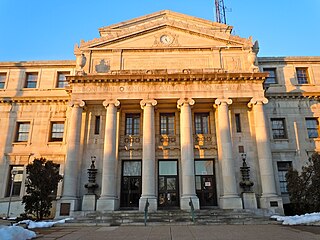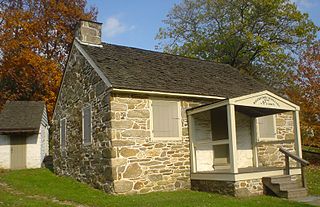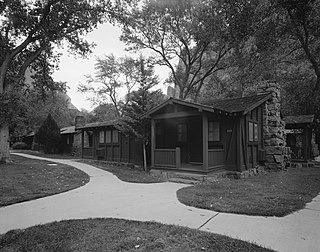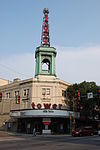
Delaware County, colloquially referred to as Delco, is a county in the Commonwealth of Pennsylvania. With a population of 576,830 as of the 2020 census, it is the fifth-most populous county in Pennsylvania and the third-smallest in area. The county was created on September 26, 1789, from part of Chester County and named for the Delaware River.

Drexel Hill is a neighborhood and census-designated place (CDP) located in Upper Darby Township, Pennsylvania, United States. The population was 29,181 at the 2020 census, an increase over 28,043 in 2010, and accounting for over one-third of Upper Darby Township's population.

Upper Darby Township, often shortened to Upper Darby, is a home rule township in Delaware County, Pennsylvania, United States. As of the 2020 census, the township had a total population of 85,681, making it the state's sixth-most populated municipality after Philadelphia, Pittsburgh, Allentown, Reading, and Erie. Upper Darby borders Philadelphia, the nation's sixth-most populous city, and constitutes part of the Delaware Valley, also known as the Philadelphia metropolitan area, the nation's seventh-largest metropolitan area.

Darby Creek is a tributary of the Delaware River in Chester, Delaware and Philadelphia counties, in the U.S. Commonwealth of Pennsylvania. It is approximately 26 miles (42 km) long. The watershed of the creek has an area of 77.2 square miles (200 km2). It has twelve named direct tributaries, including Cobbs Creek, Little Darby Creek, Ithan Creek, and Muckinipattis Creek. The creek has a low level of water quality for most of its length. The lower Darby Creek area was deemed a Superfund site by the U.S. Environmental Protection Agency (EPA) due to contamination with dangerous chemicals from two landfills.

West Overton is located approximately 40 miles (64 km) southeast of Pittsburgh, in East Huntingdon Township, Westmoreland County, Pennsylvania, United States. It is on PA 819 between the towns of Mount Pleasant and Scottdale. Its latitude is 40.117N and its longitude is -79.564W.

Pont Reading is an historic, American home that is located in the Ardmore section of Haverford Township, Delaware County, Pennsylvania. It was the residence of shipbuilder and architect Joshua Humphreys; he lived here his entire life. It was named after his family's homestead, Reading Pont in Wales.

The Federal School is a historic one-room schoolhouse located on Darby Road in Haverford, Pennsylvania near the Allgates Estate. It was established in 1797, and was called the Federal School because of the community's pride of being part of the Federal United States, but not much else is known about it until 1849, when the Commonwealth of Pennsylvania purchased the building and officially renamed it the Haverford Seminary Number 1. It served as a public school from then until Horatio Gates Lloyd bought it in 1940. After his family moved out it served as a storage building. The Historical Society of Haverford Township restored it in 1991. The Federal School now has 1849 school re-enactments for 4th Graders in the School District of Haverford Township.

The Lawrence Cabin is a log cabin located on Cobbs Creek in Powder Mill Valley Park in Havertown, Pennsylvania, near Nitre Hall.

The Philadelphia Quartermaster Depot, now known as the Defense Logistics Agency Troop Support, was founded as the Schuylkill Arsenal in 1799.

Mauricetown is a census-designated place and unincorporated community that is part of Commercial Township in Cumberland County, in the U.S. state of New Jersey.

Historic RittenhouseTown, sometimes referred to as Rittenhouse Historic District, encompasses the remains of an early industrial community which was the site of the first paper mill in British North America. The mill was built in 1690 by William Rittenhouse and his son Nicholas on the north bank of Paper Mill Run near Philadelphia, Pennsylvania. The district, off Lincoln Drive near Wissahickon Avenue in Fairmount Park, includes six of up to forty-five original buildings. RittenhouseTown was listed on the National Register of Historic Places and was designated a National Historic Landmark District on April 27, 1992.

The Philadelphia Lazaretto was the Second quarantine hospital in the United States, built in 1799, in Tinicum Township, Delaware County, Pennsylvania. The site was originally inhabited by the Lenni Lenape, and then the first Swedish settlers. Nearby Province Island was the site of the confinement of the Christian Moravian Indians who were brought there under protective custody from Lancaster, Pennsylvania, in 1763 when their lives were threatened by the Paxton Boys. The facility predates similar national landmarks such as Ellis Island Immigrant Hospital and Angel Island and is considered both the oldest surviving quarantine hospital and the last surviving example of its type in the U.S.

The Thomas Mill Covered Bridge, aka the Thomas Mill Bridge or the Thomas Mill Road Covered Bridge, is a historic, single-span, wooden covered bridge across the Wissahickon Creek in Wissahickon Valley Park in Northwest Philadelphia, Pennsylvania.

The Bar B C Dude Ranch was established near Moose, Wyoming in 1912 as a dude ranch by Struthers Burt and Dr. Horace Carncross, using their initials as the brand. Rather than converting a working ranch, Burt and Carncross built a tourist-oriented dude ranch from the ground up, using a style called "Dude Ranch Vernacular", which featured log construction and rustic detailing. As one of the first dude ranches in Jackson Hole, the Bar B C was a strong influence on other dude ranches in the area, and employed a number of people who went on to establish their own operations. It was acquired by the National Park Service and incorporated into Grand Teton National Park upon the expiration of a life estate. The ranch was listed on the National Register of Historic Places in 1990.

Creek Road station is a SEPTA Route 102 trolley stop in Drexel Hill, Pennsylvania. It is located at the end of Station Road north of Creek Road within Indian Rock Park, a 21.9-acre (89,000 m2) Natural Environmental Park in Drexel Hill, containing picnic tables, playground equipment, basketball courts, and Darby Creek.

The Zion Lodge Historic District surrounds the rustic lodge originally designed by Gilbert Stanley Underwood in Zion National Park. The lodge served as the center of a group of cabins, employee dormitories and support buildings which are included in the district. A swimming pool and bathhouse were demolished in 1976. The district was expanded in 1986 to include an Underwood-designed former photography studio and additional cabins.

John Turn Farm is a historic farm complex located in the Delaware Water Gap National Recreation Area at Middle Smithfield Township, Monroe County, Pennsylvania, USA. The complex includes the lime kiln, smoke house and weave house. The property also includes the site of the demolished main farmhouse, a smaller house, a barn and garage.

The Nyce Farm, also known as the Eshback Farm and Van Gordon House, is an historic, American home and farm complex that is located in the Delaware Water Gap National Recreation Area in Lehman Township, Pike County, Pennsylvania.

The Old Mine Road Historic District is a 687-acre (278 ha) historic district located along Old Mine Road in Sussex County and Warren County, New Jersey. It is part of the Delaware Water Gap National Recreation Area. The district was added to the National Register of Historic Places on December 3, 1980, for its significance in agriculture, archaeology, architecture, commerce, exploration/settlement, and transportation. It includes 24 contributing buildings and five contributing sites.

Mortonson–Van Leer Log Cabin, also known as Schorn Log Cabin, is a historic cabin and one of the last historical dwellings in Swedesboro, New Jersey, United States. It stands on the grounds of the cemetery of the Trinity Church. It is one of the oldest original log cabins of early Swedish-Finnish architecture in the United States.
Ambrose, George. —'The Log Cabins of New Sweden'.The New Sweden Centre, Wilmington, DE (2003).
Smith, Thomas R. Drexel Hill 1875-1912. Life in Addingham and Garrettford/America's Clandestine Hollywood. Drexel Hill, PA (1980).



























